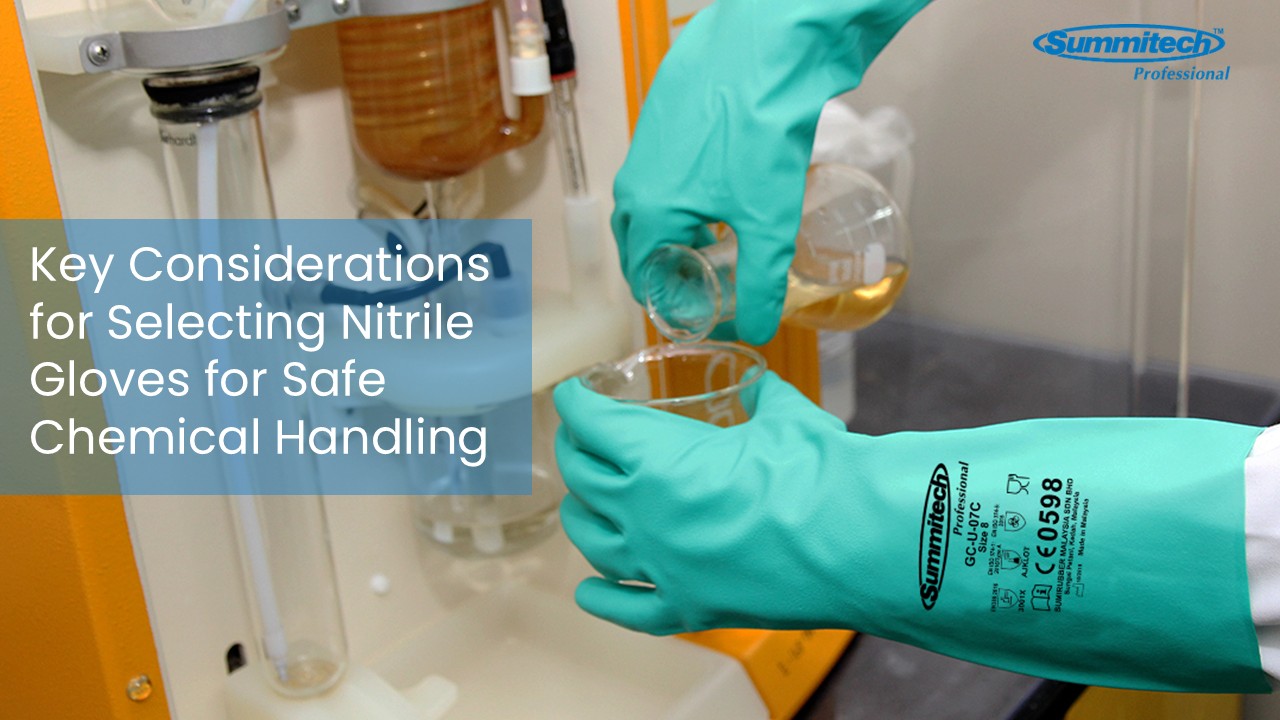June 17, 2025
Key Considerations for Selecting Nitrile Gloves for Safe Chemical Handling

When it comes to chemical handling, safety is non-negotiable. Nitrile gloves have become a preferred choice in laboratories, industrial settings, and even medical environments due to their superior resistance to a broad range of chemicals compared to latex or vinyl. However, not all nitrile gloves offer the same level of protection.
Here are six essential factors to consider when choosing nitrile gloves for chemical handling:
1. Chemical Compatibility
Not all nitrile gloves protect against every chemical. Before use, always consult a chemical compatibility chart to ensure the glove material resists permeation or degradation from the specific chemicals you'll be handling. Certain solvents, acids, or oils may require thicker or specially formulated nitrile gloves.
Please refer to the link for the Chemical Resistance Guide, which provides information on chemical compatibility. https://www.sumirubber.com/chemical-resistant-guide
2. EN374 Standard for Chemical Protection
When selecting nitrile gloves for chemical handling, make sure they comply with the EN ISO 374 standard, which specifically addresses gloves’ resistance to chemicals and microorganisms. There are different levels under EN374:
- EN ISO 374-1: Assesses protection against dangerous chemicals. Gloves are tested for permeation by specific chemicals and classified (Type A, B, or C) depending on how many chemicals they resist and for how long.
- EN ISO 374-5: Indicates protection against microorganisms, including viruses.
Always check the EN374 pictograms and code letters on the glove packaging — they identify the chemicals tested and the glove’s performance level. This ensures you're using gloves tested under stringent conditions to provide reliable chemical protection.
3. Glove Thickness and Durability
Glove thickness, usually measured in mils (1 mil = 0.001 inch), plays a vital role in chemical resistance. Thicker gloves (6 mil and above) offer greater protection and durability, especially for extended use or contact with harsh chemicals. However, they may reduce tactile sensitivity, so it's essential to balance safety with usability.
4. Glove Length and Coverage
Standard gloves cover just past the wrist, but when dealing with splashes or immersion, longer cuffed gloves (up to the elbow) are recommended. Choosing the right length depends on the risk level and how chemicals are used in your process.
5. Grip and Texture
Chemical handling often requires a secure grip. Textured fingertips or palms improve control when handling slippery or wet containers, enhancing both safety and efficiency. For oily environments, consider fully textured gloves for better performance.
6. Comfort and Fit
Chemical handling often involves extended wear. Ill-fitting gloves can cause hand fatigue or increase the risk of tears. Look for nitrile gloves available in multiple sizes with features like ergonomic design and flexibility for maximum comfort without compromising protection.
Final Thought
Selecting the right nitrile gloves is a critical safety decision. From the type of chemicals to the nature of the task, each detail matters. At Summitech Professional, we specialize in professional-grade nitrile gloves tailored for industrial safety, lab work, food handling, and beyond.
Protect with confidence. Choose the gloves that are born for the matter.
Our specialists are available to assist you in selecting the appropriate chemical-resistant gloves to ensure optimal protection.
www.sumirubber.com | +604-4213121 | [email protected]
Recent Tips
April 14, 2025
Select The Right Glove For The Right Job






